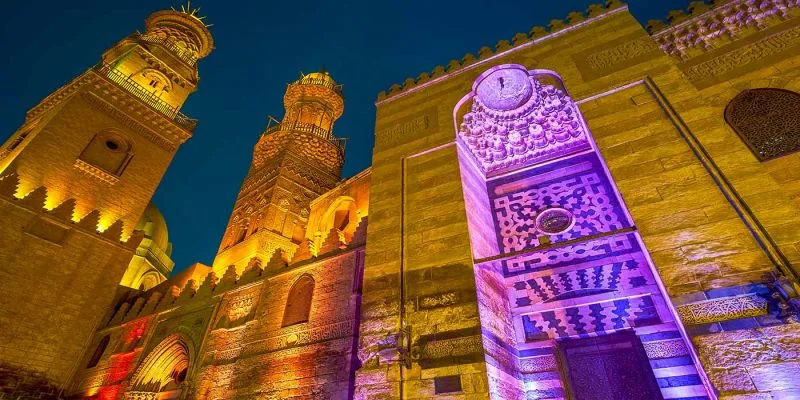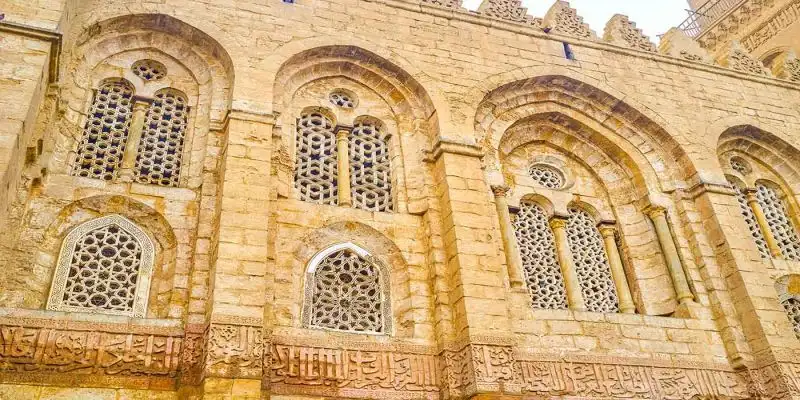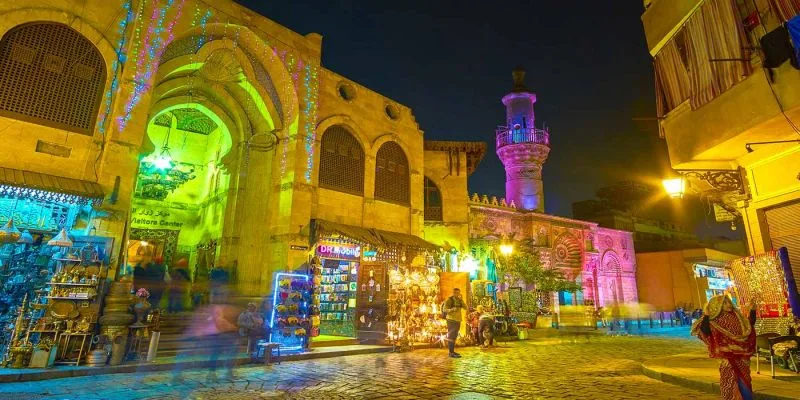Sultan Al Mansur Qalawun Mosque

Sultan Al Mansur Qalawun Mosque stands as one of Cairo's most magnificent yet often overlooked architectural treasures. Hidden within the bustling streets of the Islamic Quarter, this 13th-century complex represents far more than just a place of worship. While tourists often visit Cairo’s more famous landmarks, this Mamluk masterpiece quietly showcases some of the most exquisite Islamic craftsmanship in Egypt.
The Historical Roots of Sultan Qalawun’s Mosque
Sultan Al Mansur Qalawun rose to power during the Mamluk era, a time when Egypt flourished as a cultural and political hub. His reign was marked by an ambitious vision to strengthen Cairo’s architectural and civic identity. The Qalawun complex was built in the heart of Bayn al-Qasrayn, one of Cairo’s most prestigious areas, historically home to royal palaces and religious institutions.
The choice of this location was symbolic—it connected Qalawun’s legacy to the grandeur of earlier Islamic dynasties. The mosque complex not only served spiritual purposes but also reinforced Qalawun’s political authority, cementing his influence over both the city and the empire.
Construction and Controversy Behind the Complex
Rapid Construction Timeline
The Qalawun complex was completed in an astonishingly short period—just 13 months between 1284 and 1285. The hospital was finished first, followed by the mausoleum and madrasa. All three buildings were connected by a long central corridor that unified the complex, reflecting remarkable planning and architectural innovation.
Leadership and Labor
The project was supervised by Amir Alam al-Din al-Shuja’i, whose determination ensured the project’s rapid completion. However, his methods were controversial. To meet deadlines, he employed forced labor, including Mongol prisoners of war, and redirected nearly all of Cairo’s builders to the project. Property owners were evicted from the site, and their land was seized to make space for the new structure.
Public and Religious Backlash
These coercive tactics drew criticism from religious scholars, who questioned the moral legitimacy of a religious complex built through forced labor and confiscation. Some even called for a boycott. However, upon completion, the complex’s beauty and grandeur earned admiration and respect, transforming initial resentment into lasting reverence.

Architectural Layout and Functional Design
A Multifunctional Civic Complex
The Qalawun complex was revolutionary in its design, combining a mosque, a madrasa, and a hospital within one architectural unit. This created a multifunctional civic space that catered to the community’s spiritual, educational, and medical needs.
Visitors entered through an elegant arched portal leading to the madrasa on one side and the mausoleum on the other, both connected by a long corridor. The hospital was located at the rear and served as one of Cairo’s most advanced medical institutions for over 500 years.
The Central Corridor
The central passage served as the complex’s spine, linking all three sections. Apartments and student quarters were built above, creating a lively environment where scholars, patients, and worshippers coexisted. The design reflected thoughtful spatial organization—balancing religious orientation with practical use.
Integration of Education and Healthcare
The madrasa offered instruction in the four Sunni schools of law, as well as medicine. Medical students received practical training at the adjacent hospital. The hospital’s facilities included wards, storage rooms, and mortuaries, with a policy of free care for all, regardless of social class or background. Patients were treated, clothed, and even given financial aid upon discharge—making the complex not only a religious center but also a model of medieval social welfare.

Artistic and Structural Highlights
The Dome and Octagonal Mausoleum
The complex’s most striking feature is its octagonal mausoleum crowned by a grand dome. Supported by eight Corinthian columns, this space echoes the sacred geometry of the Dome of the Rock in Jerusalem. Historically, it also served as a ceremonial site where new emirs were invested with power.
The Exquisite Mihrab
The mausoleum’s mihrab is among the largest and most ornate in Egypt. It features a horseshoe arch framed by marble columns and adorned with intricate mosaics and mother-of-pearl inlays. Its patterns of stars and polygons reflect the pinnacle of Mamluk decorative art.
Decorative Elements and Gothic Influence
The interior walls are lined with marble panels, carved stucco, and gilded wooden ceilings. The Gothic-inspired façade, with its pointed arches and ornamental stonework, shows the influence of European Crusader architecture—an unexpected yet harmonious blend of styles.
The two minarets, distinguished by their fluted domes and zigzag carvings, were among the first of their kind in Egypt. Their innovative design introduced architectural elements that would later become standard in Mamluk construction.

Customize Your Dream Vacation!
Get in touch with our local experts for an unforgettable journey.
Plan Your Trip
Restoration Efforts and Modern Legacy
Early Restorations
After an earthquake in 1302, Sultan Qalawun’s son, Al-Nasir Muhammad, led major restoration works, including rebuilding damaged sections of the complex. His efforts preserved the structure’s integrity and ensured its continued use.
Ottoman and Modern Renovations
In the 18th century, Ottoman Governor Abdul-Rahman Katkhuda undertook further repairs, adding a public fountain opposite the mosque. Modern restoration in the 20th and 21st centuries has focused on structural reinforcement, waterproofing, and restoring intricate decorations.
The Complex Today
Today, the Sultan Qalawun Mosque and its remaining structures remain a central feature of Islamic Cairo. Visitors can admire its architectural beauty and explore the rich layers of history it represents. It stands not only as a religious site but as a living museum of medieval Egyptian art, architecture, and civic life.
The mosque is located in Cairo’s Islamic Quarter, specifically in the historic Bayn al-Qasrayn area, one of the city’s most famous heritage streets.
The complex includes a mosque, a madrasa (religious school), and a hospital, all connected by a central corridor.
Construction began in 1284 and was completed just 13 months later, in 1285.
Its blend of Islamic and Gothic styles, octagonal mausoleum, elaborate mihrab, and fluted minarets make it one of Cairo’s most distinctive monuments.
Yes, the mosque and its surrounding structures have been restored multiple times—from the Mamluk and Ottoman periods to modern preservation projects—ensuring their continued legacy.






























